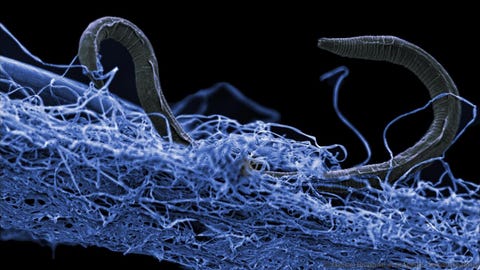Vast Ecosystem of Underground Organisms Holds More Life Than Earth's Oceans
Life on Earth pales in comparison to what's lingering beneath the surface.
By Sam Blum GAETAN BORGONIE (EXTREME LIFE ISYENSYA, BELGIUM)
GAETAN BORGONIE (EXTREME LIFE ISYENSYA, BELGIUM)As climate change reduces Earth's biodiversity, a vast ecosystem of microbes is thriving beneath the planet's surface, teeming with hundreds of millions of microscopic lifeforms.
According to a consortium of researchers from the Deep Carbon Observatory (DCO), the massive subterranean biosphere contains enough organisms to eclipse Earth's oceans nearly twice over. In a ten-year study, the DCO probed beneath the Earth's surface at locations across the globe, finding that the underground biosphere extends some three miles deep. The international group of scientists will present its findings at the American Geophysical Union in Washington, D.C., next week.
Most of the lifeforms discovered are bacteria and other single-cell microorganisms, such as archaea, but their sheer mass equals roughly 15 to 23 billion tonnes of carbon—more than humanity's total imprint on the surface. In total, 70 percent of the planet's bacteria and archaea reside underground, representing what the organization calls a "Galapagos of the deep."
The findings were made possible by recent advancements in scientific drilling. The Japanese vessel Chikyu was instrumental in helping researchers construct boreholes and mines some three miles deep.
Some species have thrived beneath the surface for millennia, despite conditions that would hamper their survival on the ground. Researchers found that microbial life can survive at temperatures up to 251 degrees Fahrenheit, whereas the limit is around 159 degrees F on Earth. These organisms necessarily require little sustenance to generate energy.
Karen Lloyd, a researcher from the University of Knoxville, Tennessee, said in a statement:
“Ten years ago, we knew far less about the physiologies of the bacteria and microbes that dominate the subsurface biosphere. Today, we know that, in many places, they invest most of their energy to simply maintaining their existence and little into growth, which is a fascinating way to live."
Among those questions waiting to be explored is how microbial life travels and spreads beneath the surface, and whether organisms use methane, hydrogen, or other elements to generate energy.
Sources: Deep Carbon Observatory, The Guardian
No comments:
Post a Comment